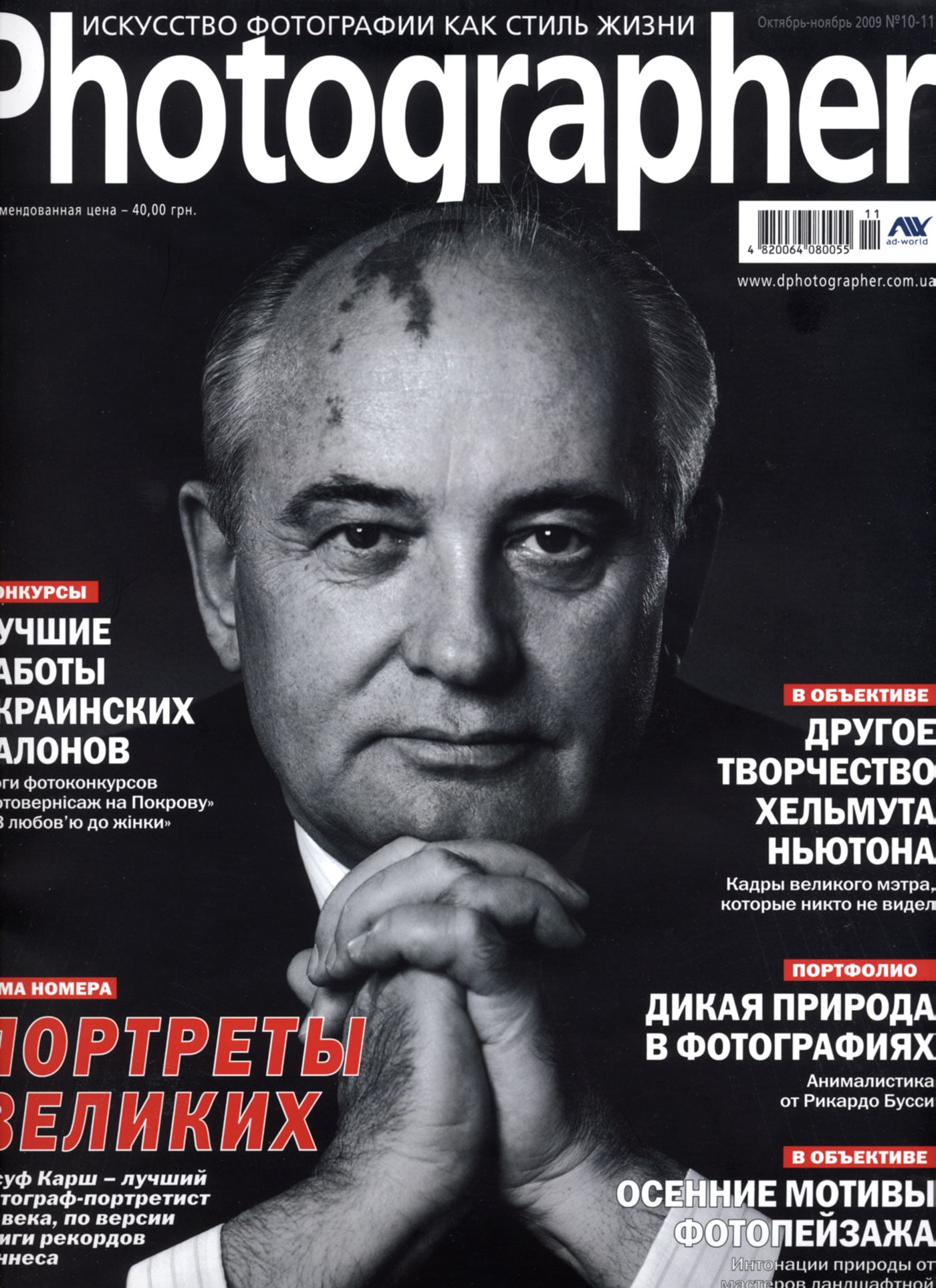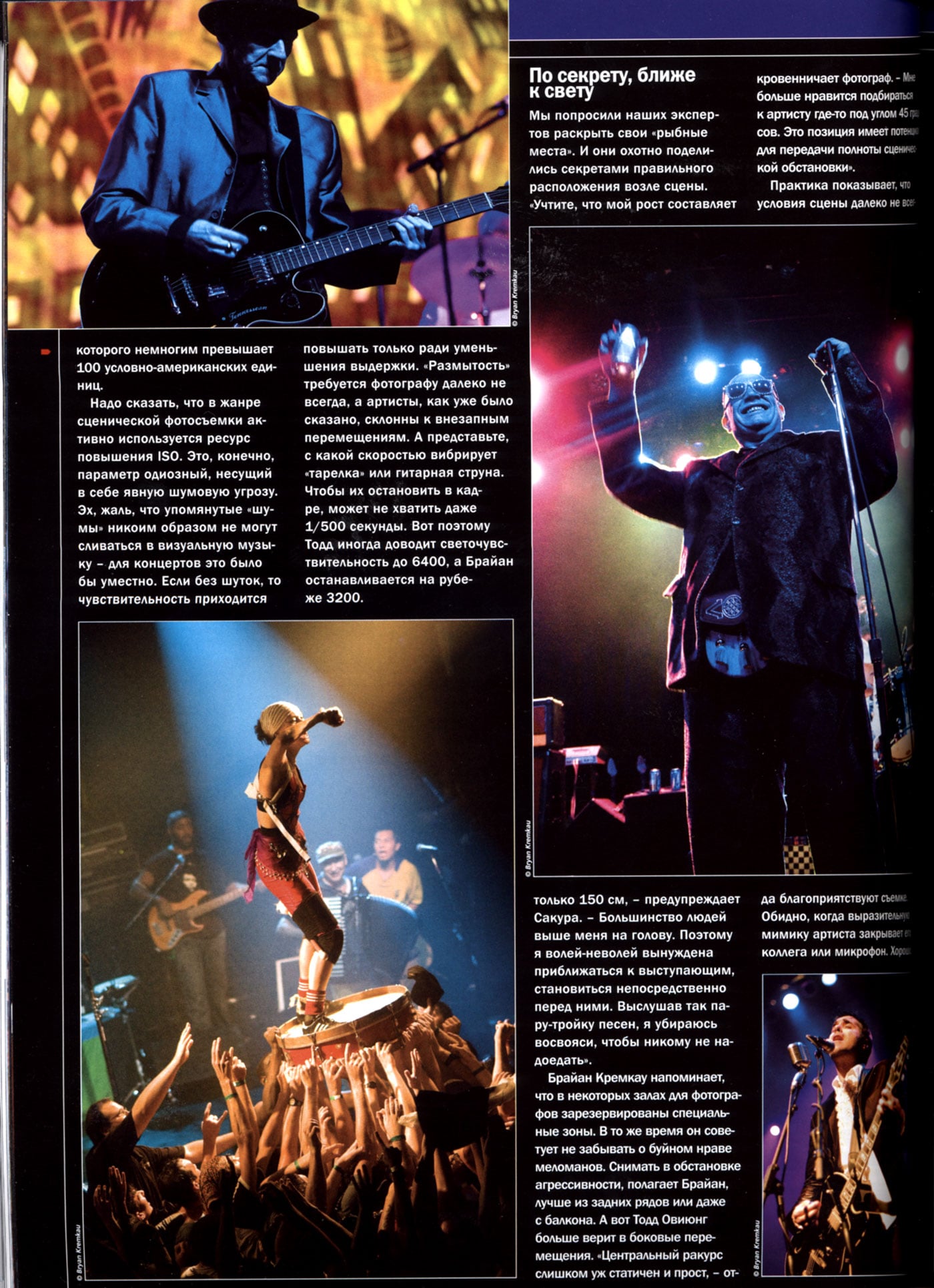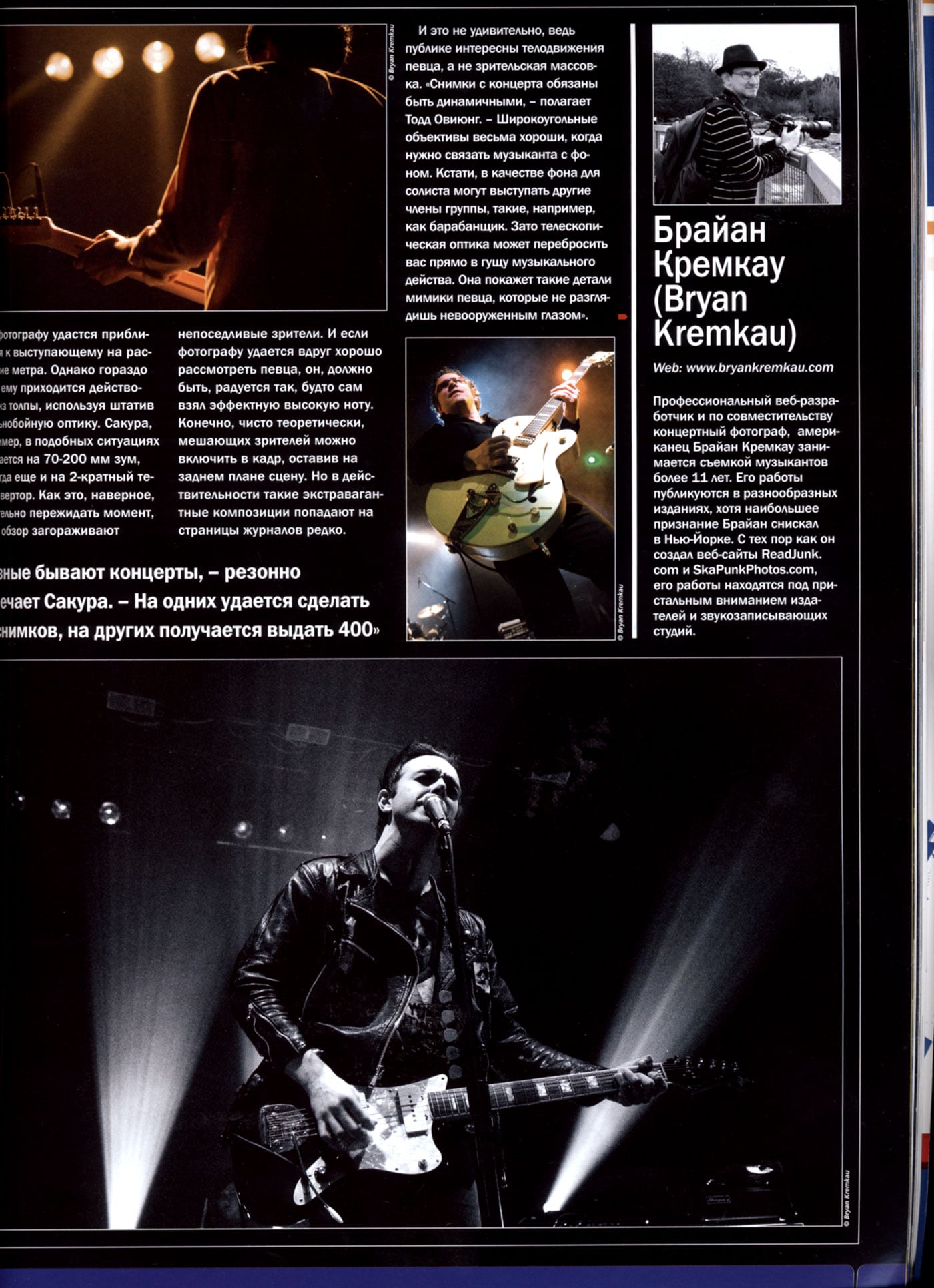
Interview: Photographer Magazine (Ukraine Edition)
March 26, 2010 | Concert Photography
Photographer Magazine (Ukraine Edition) wrote a feature about concert photography in a recent issue of their magazine. I believe it’s issue Oct-Nov 2009. It features myself, Todd Owyoung and Sakura. I’m not sure you’ll be able to get a copy of the magazine in any stores in this country but perhaps in Eastern Europe and overseas? You should definitely check out the magazine because has a lot of beautiful photographs in it. I have no idea what was written (hopefully something good haha!) but I do have the original interview, which they used certain quotes from. Below you’ll find the tearsheets (magazine scans) and the original interview. Thanks to Evgeniy Zubenko for publishing my photos and for conducting an interview with me!
Here are the scans from the Magazine:




Here’s my interview with Photographer Magazine (Ukraine Edition):
1. When did you realize that you have a big passion towards photography? I suppose you are a big music fan and visited many concerts before starting photographing them, right? Who was in your first successful photograph and how your serious coming into this genre of photography happened?
I’ve always been a huge music fan and went to a lot of shows throughout the years without a camera (or with a point & shoot camera). I realized I loved photography in college, back in 1998. I bought my first film camera for a class and started taking photographs at local punk and hardcore shows in Scranton, Pennsylvania. At first, I was just taking pictures for the class but found the experience exhilarating. The very first concert I went to with my film camera, one of the local bands’ guitarist decided to light his guitar on fire. I knew then that I wanted to photograph concerts and capture things like that.
2. Do you practice concert photography on a regular basis? Is it your primary source of income nowadays? Who is your clients and how large is such a market today comparing to previous years?
Concert photography isn’t my main source of income, but I would love for it to be. I’m a web designer during the day; at night I’d like to take in as many shows as I can. Right now, I shoot for my own websites ReadJunk.com and SkaPunkPhotos.com, as well as Prefixmag.com. My photos have also been published in Alternative Press Magazine, as well as Altpress.com, Blender.com, various MySpace.com band profiles, and other blogs & websites. From what I noticed, the market for concert photography is growing, but so is the competition. Everyone wants to be a concert photographer these days!
3. Do you photograph many musicians or you go photographing only beloved ones? In case you do not like the performance does it influence somehow the final result? And if you are a big fan of the band that you are photographing, does it really help you to feel inspiration and therefore to produce outstanding pictures?
Usually, I attend concerts of bands that I enjoy or can appreciate. With that said, I still approach each show the same as any other. It certainly helps to know the music of the band you’re shooting because you might know when the singer steps away from the microphone, or there’s a breakdown in the song. For instance, since I’m a big fan of The Pogues, I know the exact times Shane MacGowan will scream into the microphone. It’s the little things like that help with shooting bands.
4. Are there certain time frames when musician are best to be photographed or photographer should ALWAYS look in the viewfinder following musicians waiting for interesting moments? Please describe your preferable style of composing the scene?
Concert photography is always spontaneous and unpredictable. Anything can happen, so you have to be alert when shooting. I don’t necessarily think there’s a special time to take a picture of a musician. I just look for certain poses: “guitar faces,” jump shots, unique compositions, colorful lighting. Something you don’t normally see in concert photography. I try not to always look into the viewfinder because you need to be aware of your surroundings. You need to have that other eye open sometimes because a crowd surfer could be coming your way, or another band member might be doing something interesting that’s worth taking a picture of.
5. What is the best place to occupy for doing the photo session? In case you can’t get the official photo pass, but therefore need to photograph where will you be located?
I tend to be right up front, usually in the middle to start off. If I can’t get a photo pass for a concert, I try to get to the venue early enough to get up front. It really depends on the type of bands playing because if it’s a rowdy show; I tend to stay in the back/sides or in the balcony. I’m daring but not that daring! I like photo pits because it’s less stressful for me. I like being able to roam around the pit, getting the shots I want and without having to be in the audience’s way.
6. Except for the low light, what are the most hard-to-overcome obstacles during shooting? And on the contrary, which moments unfolding on a stage are considered to be the most photographically interesting which a professional shouldn’t miss?
Some of the obstacles are: shooting for only 2 or 3 songs, red lighting, no front lighting, too many microphones blocking the view of the performer, incoming crowd surfers, etc. The list goes on but that’s half the fun with shooting concerts; trying to overcome all of those obstacles and getting a shot that stands out from other photographers.
7. What kind of additional elements of a composition help the viewer to feel the style of the music and the energy of the musician or singer? In which situations you prefer the composition to be as simple as possible (say a portrait of playing guitarist occupying the whole frame with tiniest portion of a clear white or clear black background) and in which situation you try to fill the frame with as much details as possible?
For fast or loud music, I try to capture the band’s energy by showing all the details in their live show. I like to capture everything ranging from the lighting to the band head-banging along to their music; getting the crowd into the shots helps as well. For slower music, I try to simplify the shot and have the musician or band as the main focus.
8. How many camera bodies you use? Do you have 2 separate bodies one for wide-angle scenes and another one for portraits or you use just single camera body? What is you favorite lenses for live concert and accessories? Please share your photo kit.
Unfortunately, I only use 1 camera body during concerts. I’ve become very quick at changing lenses in-between songs or even during songs that I can still deal with one camera. The downside to this is losing at least 15 seconds changing the lenses where you could have been shooting. I shoot with the Nikon D300 and mostly use the 50mm f1.4, the 70-200mm f2.8, and an older kit lens 18-70mm f3.5-4.5. Until I can save up for the 14-24mm f2.8 or 24-70mm f2.8 lenses, the kit lens will have to do. My favorite lens is probably the 70-200mm f2.8 lens because I use it just about every time I shoot a concert. A wide angle lens like 14-24mm f2.8 would probably be my favorite if I had one.
9. How you overcome the low sensitivity and what is the appropriate ISO for having the images to be clear from noise and adoptable to be printed a double – page layout in a magazine? In case there is not so much available light for crisp images what are you doing then?
ISO 1600 on the Nikon D300 is great for both web and print, so I try to stay around that. A lot of the time I have to go higher than that but I try not to go to ISO 3200. With the Nikon D300, ISO 3200 is too grainy and the photos might not be good enough to print. When the ISO is maxed out, and there’s nothing I can do about; I try to hold the camera as still as possible to get a clear shot. Or if it’s allowed, I might use my speed light but I try to avoid using that. When all else fails, I switch the photos to black & white in post-production for an old-fashion grainy look.
10. Do you need to change your location from time to time during a performance? How to organize shooting from the behind of the stage or from other places which normally are not allowed even for photographers?
I always need to change my location throughout the short time of shooting a set. I stand in front, on the sides, and even in the back to get an overall shot of the venue and the crowd. Getting different perspectives from the show is important to me. It’s frustrating sometimes when I can’t do that, especially when the venue is sold out and it’s hard to move around. To shoot from the stage or behind the stage, you need an “all-access” pass, which is something I rarely get. I’d actually rather be in front of the band so I never pursued getting one of those passes.
11. What is the minimal distance a photographer can approach the performer during the concert?
I don’t know what the minimal distance is but I know not to get too close to the bands. You don’t want them hitting you over the head with their instruments! Plus, I’m not one of these photographers, but I’ve seen people shove their cameras in the bands’ faces and pop their flash off at them. I just think that’s really rude and distracting to the band and to the audience.
12. Is continuous changing of the color and intensity of the stage light influences the shooting procedure? How often do you need to change the camera settings during the photo shoot? Do you rely on automatic settings in such unstable lighting conditions or apply bracketing?
When shooting, I try to adjust to the lighting as best as I can. For example, if the lighting contains a lot of red, I try to increase the shutter speed so the highlights aren’t blown out. One of the challenges with concert photography is trying to find the right settings to shoot at. I rarely bracket my shots and only remember doing it once during a concert with really erratic back lighting. For me, I’d rather intentionally compose and shoot something than getting a lucky shot just because my finger was repeatedly hitting the shutter button.
13. How many pictures do you usually take during the concert? You prefer to make a set of continuous frames with long intervals between shooting or you make 1-2 shots but prefer pretty often ?
It really depends on how many bands are playing the concert. My sets of photos for each band ranges from 30 photos to 300 photos. I remember the last time I shot Gogol Bordello; I ended up taking over 300 photos. With a band like that, you just snap away and get into the energetic music. For me personally, I don’t shoot a set of continuous frames because in the end, I’ll just end up picking one of those photos to feature.
14. If you are shooting on the assignment, what kind of instructions you usually receive from editors? Do they demand original, fresh perspectives or there is a classical approach in this genre which all the editors try to comply with?
From the shows I’ve shot on assignment, the editor just wants to have various perspectives from the show. Sometimes they want crowd shots, other times they don’t give any instructions at all. I actually like having the freedom of shooting and shooting what people might like.
15. What is your most memorable shooting? Most memorable and favorite frame?
I’m not sure if I have one memorable concert shooting experience but I’ll say Gogol Bordello put on one of the best live shows ever! The things they do during their show are very exciting both as a fan and a photographer. The very first time I shot their show, Eugene Hutz opened up a champagne bottle and it went all over the place. I luckily captured that, using my flash. But that isn’t my favorite shot of them. It’s probably the shot of Pamela of Gogol Bordello standing on the drum at Irving Plaza in New York City. After shooting the band in the beginning of their set, I went upstairs to watch from the balcony. I kept my camera out, knowing that she was going to get up there at the end of the show. I got my 85mm f1.8 lens out and got a few shots of her. To this day, those shots still remain my favorite.
Tags: Concert Photography, interview, magazine scans, music photography, photographer magazine, Photographer Magazine (Ukraine), published, tearsheet, tearsheets

Share This Page